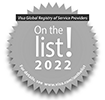Welcome to the Healthy Habit Hacks blog! We’re here to help turn your healthy intentions into habits that stick, providing tips to move from wishing to doing.
The Healthy Habit Hack: Track your actions!
With any health goal, tracking your actions is one way to help you get started and stay on track to progress over time. Did you know that 69% of U.S. adults use tracking to manage their health or that of a loved one? Self-tracking is the practice of repeatedly recording information.
Tracking your actions does several things.
- It raises your awareness and provides a record of how you spend your time. Sometimes, just knowing that you will be documenting your behavior helps you stay accountable and focused on your goal.
- Using a tracker or keeping a log for a period of time can help you learn what works well for you and what your stumbling blocks may be.
- A log helps you identify patterns, triggers that may interrupt your efforts, and cues that may prompt you to change.
- Reviewing your log and looking for patterns and cues that work can help you stay focused and give you the confidence to stay on track while seeing what challenges you face may help identify when and where to seek support.
Where and how often do I track my actions?
Record or log your actions in any way that works for you. You may use a digital device, smart phone note or find a tracking app that you enjoy, or you might like to keep a paper log, calendar or journal.
Plan to track your actions regularly. When starting habits to help you achieve a specific goal, like eating more fruits or eating less sugar, tracking every day for one to two weeks can be beneficial. The first couple weeks of action can help you fully understand your patterns, and then continuing to track at least several days a week after continues to build the habit. On the other hand, longer-term goal like losing weight, quitting smoking, or managing a medical condition like high blood pressure may require daily logs for a longer period of time before moving on to less frequent (but regular) tracking. If you struggle to track everyday at first, start small and track twice a week then build up to logging your actions 6 or 7 days a week.
Building Healthy Habits
As you’re working on building a healthy habit, start by picturing where you want to be and write or sketch it in your log. For example, if you’re planning to exercise more, draw a picture or find a photo of yourself exercising and feeling energetic. Next, determine your specific goal for the behavior you’re working toward.
Goals example:
- I will eat a high-fiber breakfast 6 days a week
- I will meditate for 10 minutes 4 days a week
- I will exercise 30 minutes 5 days a week
Next, assess your actions in the log or tracker that work for you. Log your behavior for at least one week so you can get an accurate view of your current habits. When you log your actions, you may also want to log your feelings, where you were, who you were with, if anything caused you to act the way you did. These insights can help you create an action plan to achieve your goal and assess what barriers might hold you back.
After a set period of time, review and adjust your actions. If you’ve reached your goal, celebrate your success and reinforce the action or situation that helped you stay on track. If you haven’t quite progressed as you’ve hoped, examine what is stopping you. You may want to adjust your goal to something more realistic, or focus on a different aspect of health until you find some momentum.
Give this tracker a try to get started with exercise – or this one with mental wellbeing.
Breaking Bad Habits
If your goal is to break a bad habit, still start by picturing where you want to be. Write or sketch it in your log. For example, if you’re planning to quit smoking cigarettes, draw a picture or find a photo of yourself feeling accomplished and smoke-free. Next, determine your specific action for the goal you’re working toward.
Goals could be long-term or short-term:
- I will quit smoking within 6 months
- I will journal every cigarette I smoke for 14 days
- I will delay my first cigarette of the day until after 2:00pm for seven days
Next, log your actions as well as your feelings, where you were, who you were with, if anything or any person or feeling caused you to meet or miss your goal. These insights can help you create an action plan that works for you and address any barriers that are slower your progress.
When it comes to breaking bad habits, tracking or journaling can be critical as it helps identify triggers and temptations. Logging your cravings for sugary drinks, cigarettes, or alcohol (including environmental details like time, location, and who you’re with) may help you identify triggers and temptations that cause you to drink soda, smoke, or drink. Logging your mood and what tempted you to do so further helps you understand your current habits and reasons why you typically engage in the behavior.
Give this tracker a try to get started with cutting back on alcohol – or try this app to help you track and stop cigarette cravings.
Remember, start where you are – it’s important to have a vision and a plan before you start tracking. Consider your current strengths, past successes and leverage them to create an action plan. Then, you’re ready to track your actions. Record your progress and regularly examine your habits to identify patterns, successes and challenges. Lastly, celebrate successes and learn from your trials as you continuing progressing toward healthier habits for life.






